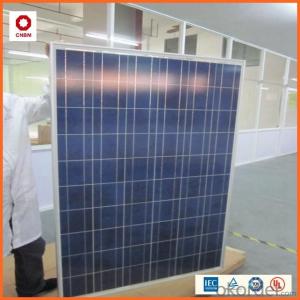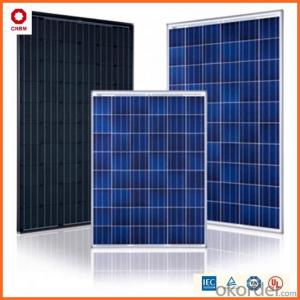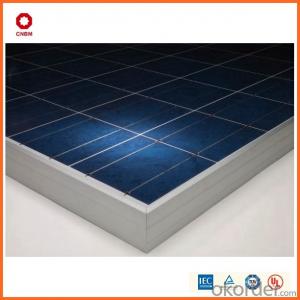35w Small Solar Panels with Good Quality
- Loading Port:
- China main port
- Payment Terms:
- TT OR LC
- Min Order Qty:
- 1 watt
- Supply Capability:
- 10000000 watt/month
OKorder Service Pledge
OKorder Financial Service
You Might Also Like
Item specifice
Product Description:
Hot Sale !!! Quality and Safety of Small Poly Solar Panel 25~85w
1. Rigorous quality control meets the highest international standards.
2. High-transmissivity low-iron tempered glass, strong aluminium frame.
3. Using UV-resistant silicon.
4. IS09001/14001/CE/TUV/UL
Warranties of Small Poly Solar Panel 35~85w
1. 10 years limited product warranty
2. 15 years at 90% of the minimal rated power output
3. 25 years at 80% of the minimal rated power output
Specification
Characteristics of Poly solar panels CNBM (25-85W) | |||||
Max Power Voltage Vmp(V) | 30.3 | 30.8 | 31.1 | 31.4 | 31.85 |
Max Power Current Imp(A) | 7.60 | 7.64 | 7.73 | 7.81 | 7.85 |
Open Circuit Voltage Voc(V) | 36.1 | 36.6 | 37 | 37.3 | 37.68 |
Short Circuit Current Isc(A) | 8.50 | 8.55 | 8.65 | 8.75 | 8.85 |
Max Power Pm(W) | 230W | 235W | 240W | 245W | 250W |
Temperature Coefficient of Cells Poly solar panels CNBM (25-85W) | |
NOCT | 45± 2 |
Temperature Coeffucients of Isc | 0.0492 |
Temperature Coeffucients of Voc | -0.3374 |
Temperature Coeffucients of Voc | -0.4677 |
Mechanical Data of Poly solar panels CNBM (25-85W) | |
Dimension | 1638 × 982 × 40 mm |
Weight | 19.5 kg |
No. of Cells and Connections | 60 (6 ×10) |
Tolerance | 0 ~ + 5 W |
Cell | Monocrystalline Cell 156 × 156 mm |
Packing | 624 Pcs/40ft(H) Container |
Limits of Poly solar panels CNBM (25-85W) | |
Operating Temperature | -40 to +85 |
Storage Temperature | -40 to +85 |
Max System Voltage | 1000VDC(IEC) / 600VDC(UL) |
Features of our products:
• High conversion efficiency mono/poly-crystalline amorphous silicon solar cells
• Modules incorporate high performance bypass diodes to minimize the power drop caused by shading
• High transmittance, low-iron tempered glass
• High performance EVA encapsulant to prevent destroying and water.
• AI frame: without screw, corner connection. 8 holes on the frame can be installed easily
• Good performance of preventing from atrocious weather such as wind and hails
• Certifications: CE IEC TUV VDE UL, Class I
• 10 years 90% power output warranty

Shipping of Small Poly Solar Panel 25~85w
By Sea | Delivery from Shanghai or Ningbo seaport |
By Air | Departure from Shanghai Pudong Airport |
By Express | Post by DHL, EMS, UPS, TNT. |
- Q:Can solar energy systems be used in conjunction with backup generators?
- Solar energy systems can indeed be used alongside backup generators, resulting in a more reliable and efficient power supply. These systems capture energy from the sun and convert it into electricity, enabling the powering of homes, businesses, and other facilities. However, solar panels only generate electricity when sunlight is available, making them inadequate during cloudy days, nighttime, or power outages. This is where backup generators come into play. They are devices that supply electricity when the primary power source is insufficient or inaccessible, such as during blackouts or when solar energy systems fail to generate enough power. By integrating backup generators with solar energy systems, a continuous and dependable power supply is ensured, regardless of weather conditions or grid disruptions. During times when solar panels generate surplus electricity, they can charge batteries that store this energy for later use. These batteries can then be utilized to power the premises during periods of low solar production or high energy demand, reducing the need for the backup generator. However, in situations where extended cloudy days or prolonged power outages occur, the backup generator can activate to supply the necessary energy, ensuring that lights stay on and essential appliances continue to function. The combination of solar energy systems and backup generators provides the advantages of renewable energy and energy independence while also serving as a backup power source when required. This integration is particularly beneficial in areas with unreliable grid infrastructure or regions prone to natural disasters. Moreover, it allows for better energy management, potentially leading to reduced electricity costs and decreased reliance on fossil fuels.
- Q:Can a solar energy system be installed in areas with heavy snowfall?
- Yes, a solar energy system can be installed in areas with heavy snowfall. While heavy snowfall can affect the efficiency of solar panels, proper design and installation can ensure their effectiveness even in snowy conditions. Here are a few considerations: 1. Tilt and angle: Solar panels are typically installed at an angle to maximize exposure to sunlight. In areas with heavy snowfall, panels can be tilted at a steeper angle, allowing the snow to slide off more easily. 2. Snow clearing: Regular snow clearing can help maintain the performance of solar panels. This can be done manually or through automated systems that use brushes or heating elements to melt the snow. 3. Orientation: Orienting the solar panels towards the south or where they receive maximum sunlight can help mitigate the impact of heavy snowfall. This ensures that when the snow melts, the panels can quickly resume their normal operation. 4. Adequate spacing: Providing sufficient spacing between solar panels can prevent snow accumulation from one panel affecting the entire system. This allows for continued energy production even if some panels are temporarily covered in snow. 5. System monitoring: Installing a monitoring system can help identify any issues with snow accumulation or reduced energy production. This allows for timely intervention and maintenance to ensure optimum performance. While heavy snowfall may temporarily reduce energy production, a well-designed solar energy system can still be a viable option in areas with these weather conditions. It is important to consult with experienced solar installers who can design and install a system that can withstand and adapt to heavy snowfall.
- Q:Can solar energy systems be used in areas with limited space for ground-mounted installations?
- Solar energy systems can still be used in areas with limited ground space. Instead of traditional ground-mounted installations, alternative options like roof-mounted solar panels or vertical installations can be utilized. Roof-mounted solar panels are particularly popular for homes and buildings with limited ground space. They make use of the available roof area to capture sunlight and generate electricity. Another option is vertical solar panel installations, where panels are mounted on walls or other structures. These vertical installations allow for solar energy generation in tight spaces or even on building facades. Therefore, even in places with limited ground space, solar energy systems can still be effectively utilized through alternative mounting options.
- Q:How do solar energy systems impact the electricity grid?
- Solar energy systems can have a positive impact on the electricity grid by reducing the demand for traditional fossil fuel-based electricity generation. As more solar power is generated and fed into the grid, it helps to diversify the energy mix and decrease the reliance on non-renewable sources. Additionally, solar energy systems can help alleviate peak demand periods, especially during sunny days, leading to a more stable and reliable grid. However, the intermittent nature of solar power can also pose challenges for grid operators in terms of managing fluctuations and ensuring grid stability.
- Q:Can solar energy systems be used in powering wineries or breweries?
- Certainly, wineries and breweries can utilize solar energy systems to effectively power their operations. Indeed, solar power has been widely embraced by many wineries and breweries worldwide as a sustainable and cost-efficient energy solution. These facilities can install solar energy systems on their rooftops or surrounding areas to capture sunlight and convert it into usable electricity. The electricity generated from solar panels can be employed to power various aspects of winemaking or brewing, including lighting, heating, cooling, and machinery. It can also be used for irrigation pumps and ventilation systems, which are critical for maintaining optimal fermentation conditions. By employing solar power, wineries and breweries not only reduce their carbon footprint and dependence on fossil fuels, but also enjoy several financial advantages. Solar energy systems can significantly decrease utility bills, as these establishments typically require a substantial amount of electricity for their operations. Furthermore, certain regions offer incentives and tax credits to businesses that adopt renewable energy sources like solar power. In addition, solar energy systems provide wineries and breweries with energy independence and reliability. These systems can generate electricity even during power outages or peak demand periods when electricity prices are higher. This ensures uninterrupted production and reduces the vulnerability of these facilities to energy shortages or price fluctuations. Overall, the effectiveness of solar energy systems in powering wineries and breweries has been well-documented, offering environmental, financial, and operational benefits. By harnessing the abundant power of the sun, these industries can contribute to a more sustainable future while enjoying the numerous advantages of solar energy.
- Q:What is the impact of roof material on the performance of solar panels?
- The impact of roof material on the performance of solar panels can vary. Certain roof materials, like metal or concrete, can enhance the performance of solar panels by reflecting sunlight onto the panels, thereby increasing their efficiency. On the other hand, materials like clay tiles or slate can create shading or uneven surfaces, which can reduce the overall output of solar panels. Additionally, roof materials with high heat absorption, such as asphalt shingles, may cause the panels to overheat, leading to decreased efficiency. Therefore, the choice of roof material plays a crucial role in determining the effectiveness of solar panels.
- Q:Can solar energy systems be used in conjunction with battery storage?
- Yes, solar energy systems can be used in conjunction with battery storage. This allows excess solar energy generated during the day to be stored in batteries for later use when the sun is not shining, such as during the night or during cloudy days. Battery storage enables a more reliable and consistent supply of electricity from solar energy, increasing energy independence and resilience.
- Q:Can solar energy systems be used for powering off-grid eco-retirement communities?
- Yes, solar energy systems can be used effectively for powering off-grid eco-retirement communities. Solar panels harness the sun's energy and convert it into electricity, providing a sustainable and renewable power source. Off-grid communities can utilize solar energy to meet their electricity needs, reducing their reliance on fossil fuels and minimizing their environmental impact. Additionally, solar energy systems can be easily installed and maintained, making them a practical and cost-effective solution for powering eco-friendly retirement communities that are disconnected from the traditional power grid.
- Q:How does the efficiency of solar panels vary between manufacturers?
- The efficiency of solar panels can differ significantly among manufacturers as a result of various factors. One primary factor is the quality of materials used during production. Panels made with high-quality materials, like monocrystalline silicon, generally exhibit higher efficiency compared to those made with lower-quality materials. Manufacturers also employ diverse manufacturing processes that can impact panel efficiency. For instance, some manufacturers utilize more advanced and precise techniques, resulting in higher efficiency panels. Moreover, the level of experience and expertise of the manufacturer can also influence panel efficiency. Furthermore, panel efficiency can be influenced by the design and engineering of the panels. Manufacturers who invest more in research and development to optimize panel design often achieve higher efficiency. Factors such as the arrangement and quantity of solar cells, electrical connections, and anti-reflective coatings all contribute to overall panel efficiency. Additionally, the size and surface area of solar panels can affect their efficiency. Larger panels generally possess more solar cells and a larger surface area to capture sunlight, leading to higher efficiency. However, this may also result in increased costs and space requirements. Lastly, the efficiency of solar panels can be impacted by the testing and certification processes. Manufacturers that conduct rigorous testing and obtain certifications from recognized authorities tend to produce more reliable and efficient panels. To conclude, the efficiency of solar panels can vary among manufacturers due to factors such as material quality, manufacturing processes, design and engineering, size and surface area, and testing and certification. Consumers should consider these factors when selecting solar panels to ensure they choose the most efficient and reliable option for their specific needs.
- Q:Can solar panels be installed on RVs or boats?
- Yes, solar panels can be installed on both RVs and boats. In fact, they are becoming increasingly popular as a sustainable and efficient way to generate electricity while on the move. Solar panels can provide a reliable source of power for various appliances and equipment used in RVs and boats, such as lights, fans, refrigerators, and even charging electronic devices. The panels are typically mounted on the roof or deck, where they can capture sunlight and convert it into usable energy. This allows RV and boat owners to reduce their reliance on traditional power sources and have greater freedom to explore remote areas without the need for electrical hookups. Additionally, solar panels on RVs and boats are environmentally friendly and can help reduce carbon emissions. However, it is important to consider the power requirements and available space before installing solar panels, as well as ensuring proper installation and maintenance to maximize their efficiency and longevity.
1. Manufacturer Overview |
|
|---|---|
| Location | |
| Year Established | |
| Annual Output Value | |
| Main Markets | |
| Company Certifications | |
2. Manufacturer Certificates |
|
|---|---|
| a) Certification Name | |
| Range | |
| Reference | |
| Validity Period | |
3. Manufacturer Capability |
|
|---|---|
| a)Trade Capacity | |
| Nearest Port | |
| Export Percentage | |
| No.of Employees in Trade Department | |
| Language Spoken: | |
| b)Factory Information | |
| Factory Size: | |
| No. of Production Lines | |
| Contract Manufacturing | |
| Product Price Range | |
Send your message to us
35w Small Solar Panels with Good Quality
- Loading Port:
- China main port
- Payment Terms:
- TT OR LC
- Min Order Qty:
- 1 watt
- Supply Capability:
- 10000000 watt/month
OKorder Service Pledge
OKorder Financial Service
Similar products
New products
Hot products
Hot Searches
Related keywords































